Preprint
Review
Development of an Integrated EV Service Ecosystem Business Model Using Community Ecology and Ecosystem Ecology Concept for Sustainable Tourism Areas: A Review
This version is not peer-reviewed.
Submitted:
06 November 2024
Posted:
08 November 2024
You are already at the latest version
A peer-reviewed article of this preprint also exists.
Abstract
The Business Model Canvas (BMC) and Value Chain have significantly impacted how companies and entrepreneurs develop their business strategies. BMC and the value chain provide a simple visual approach to effectively map out key elements in a business. BMC and the value chain have also been used as foundational models for ecosystem business models. Ecosystem business models are created by integrating the business model canvas and the pie model, known as the Integrated Business Model (IBM). Another method for generating an ecosystem business model is by integrating the value chain and the pie model, known as the Service-Dominant Business Model Radar (SDBM/R). Ecosystem business models with an organizational approach have also provided a broad view of the roles of each organization, divided into five actors: governor, input provider, aggregator, enabler, and end user. In this research, the perspective of the ecosystem business model originates from an ecological analogy. The ecological concept consists of community ecology and ecosystem ecology. Community ecology relates to the types of actors that play roles in the ecosystem, while ecosystem ecology relates to the value chain processes within the ecosystem. This research will discuss the advantages and limitations of BMC, the value chain, and organization as foundational models for ecosystem business models, as well as opportunities to create new ecosystem business models based on the concepts of community ecology and ecosystem ecology. The new business model formed will be applied to electric vehicles in sustainable tourism areas.
Keywords:
ecology business
; business model
; ecosystem business model
; electric vehicle
; sustainable
1. Introduction
Transportation mobility in tourist areas has become a global challenge [1], especially in tourist areas in Indonesia. The mobility challenges in tourist areas include traffic congestion, massive use of private transportation, and air pollution [2,3]. In Indonesia, there are several tourist areas that are frequently visited by both domestic and international tourists, but they still face mobility issues. Tourists visiting these areas using private vehicles with ICE (Internal Combustion Engine) can cause traffic congestion and air pollution.
Electric vehicle service is a solution that can be implemented to reduce traffic congestion and air pollution in tourist areas [4,5,6]. Electric vehicle services can decrease the use of private vehicles, thus reducing traffic congestion. Electric vehicles do not use fossil fuels to operate, making them environmentally friendly [7]. Various efforts have been made by the government to increase the use of electric vehicles, such as presidential regulations, regional regulations, and ministerial regulations, but these have not yet significantly increased the use of electric vehicles. An integrated electric vehicle service system, like the ecosystem business model, is essential so that the actors involved can synergize and collaborate in conducting business processes. The government is currently trying to find a collaborative model for the electric vehicle ecosystem. Government policies related to this are outlined in Presidential Regulation No. 55 of 2019 and Minister of Industry Regulation No. 27 of 2020 on the roadmap for electric vehicle development.
The ecosystem business model for electric vehicle services can be a solution in the collaboration of the electric vehicle ecosystem. An ecosystem business model is an architecture consisting of several business actors with complementary roles and functions to achieve the value proposition of the business ecosystem [1]. Business models have been used in various studies but still employ different concepts [8]. The models frequently used by researchers to explain and illustrate business models include the BMC (Business Model Canvas) [9], the RCOV business model [10], and the Teece business model [11]. These models have been widely used by researchers to explain and provide insights into ongoing business processes, but their perspective is usually limited to a single business entity. Business models have now shifted toward a broader business entity, where several companies collaborate and synergize to create a sustainable business ecosystem. Then, an ecosystem business model is needed to reanalyze the rationale of a business model due to the increasing number of business agents [12]. An ecosystem business model is also required to view business from a holistic perspective.
The ecosystem business model was first introduced by James F. Moore in 1996. This model describes how companies operate within the context of a larger environment, involving actors that interact with each other, though the components forming the model were still limited to the core business, internal company aspects, and the business ecosystem [13].
The currently evolving ecosystem business model is the integrated ecosystem business model. An ecosystem business model can be formed through the integration of the BMC concept [14] and the integration of the value chain concept [1]. The integration of BMC results in a more detailed model as well as the roles of each actor complementing one another. Integration with the value chain generates added value from each actor that supports each other.
In this study, a new ecosystem business model will be developed using the analogy of ecosystem ecology and community ecology. This new ecosystem business model is expected to result in a sustainable model. Sustainable means providing increased economic, social, and environmental value. By integrating the value chain and Business Model Canvas (BMC), a business model based on ecological ecosystems and community ecology will be produced. Through the analogy of ecosystem ecology and community ecology, it is expected that the ecosystem business model will have the following characteristics:
- Holistic: Involves all actors in the business model ecosystem.
- Detailed: Involves the business elements of each actor.
- Metaforming: Explains the value chain in the same way as the food chain in an ecosystem.
- Sustainable: Generates economic, social, and environmental value enhancement.
This business model will be utilized for the development of electric vehicle services in tourist areas.
2. Business Model
Timmers (1998) conducted a study on business models and argued that a business model is an architecture of products, services, and information flows, and includes a description of the business actors and their roles [15]. The presentation of the potential benefits for each actor is also conveyed in the business model. The revenue streams of each actor are also expected to be accommodated within a business model. Amit and Zott (2001) further refined the concept of business opportunities in a business model, stating that a business model creates value through the exploration of business opportunities[16]. This view was deepened by Chesbrough and Rosenbloom (2002), who stated that a business model is a “heuristic logic” that connects technical potential with the realization of economic value [17].
Osterwalder (2005) later introduced the concept of business models and their hierarchy, which can be seen in Figure 1 [8]. The business model functions to help understand, analyze, organize, and achieve a patentable business model. To create a business model concept, it starts with the business model concept, followed by the creation of its respective business model, then identifying similar characteristics in the taxonomy, which is then applied across various companies. The business model concept used by Osterwalder et al. has been applied in real businesses at several companies such as Dell, Amazon, and eBay.
Demil and Lecocq (2010) provided inspiration regarding the components of a business model and their relationships, which are produced through the RCOV framework. In the RCOV framework, the components of a business model include Value Proposition, Organization (internal and external), Revenue, Cost, Resources and Competencies, and Margin. The RCOV framework is illustrated in Figure 2 [10].
According to Wirtz (2010), the business model is the backbone of the ecosystem business model. It can illustrate the differences between the internal and external conditions of the ecosystem and shape them into a system architecture [18].Zott and Amit (2010) stated that the business model can analyze constraints and capabilities for business development [19], leading Gomes (2018) to assert that a business model can be understood as a tool to improve ecosystem interactions [20].As a unified analysis, the business model can help the ecosystem business model achieve its value proposition.
Business models can also be applied with a market approach influenced by technology [21], by integrating various components of the ecosystem to fulfill digitalization needs. The purpose of a business model is to explain how an organization, individual, or entire ecosystem identifies business opportunities, generates and captures value, and leverages advantages, even if full transformation is not achieved [22]. Some businesses struggle to immediately adapt to technological changes due to the rigidity of their business models and transformation strategies [23]. It is crucial for companies to remain alert to new technological developments and the roles of stakeholders within their ecosystem’s business model. Studies on business model transformation have been conducted, examining the process through three key perspectives [14].
- Holistic Perspective: Describes the actors within the ecosystem, including the network within the ecosystem and the influence of each stakeholder.
- Detailed Perspective: Describes the internal elements of each actor and the business model they possess.
- Transformation Perspective: Describes the evolving technologies within the business model.
2.1. Business Model Canvas
The most widely used model for business models is the Business Model Canvas (BMC), which incorporates nine key elements that represent various aspects of a business [24]. Figure 3 demonstrates the structure of the business model canvas, outlining its core components.
This business model adequately represents the company’s strategy. However, it is not sufficient for creating a value proposition. In the Business Model Canvas book, it is mentioned that the value proposition arises from customer perceptions [8]. This business model needs an explanation of the sources of the value proposition, similar to what is found in the Walters value chain.
2.2. Teece’s Business Model
Another well-known business model is Teece’s (2010) approach, which follows a circular method for structuring the business, as depicted in Figure 4. This model emphasizes the continuous development and interconnection of key business components [11].
Teece’s business model places greater emphasis on the process of creating a value proposition, followed by defining the market segments and how to reach those segments. It then identifies revenue sources and incurred costs, iterating through these steps to achieve the best value proposition. This process involves examining new technological opportunities that can be leveraged into a business model [11].
This model is still related to the BMC, where Stage 1 corresponds to key resources, Stage 2 relates to the value proposition, Stage 3 pertains to customer segments, Stage 4 involves revenue streams, and Stage 5 concerns cost structure. The BMC is a more structured model compared to Teece’s model. However, the Teece business model does not provide a detailed explanation of the components that constitute the value proposition.
2.3. Business Model Innovation
Significant contributions to the understanding and development of business model frameworks and value creation have shaped the way business models are applied in the modern economy. Figure 5 illustrates a business model innovation developed in 2017, which has had a notable impact on both academics and practitioners [25].
This business model innovation has several novelties. It introduces new ways of doing business, establishes customer relationships by building long-term connections with customers, provides additional services to support the products or services offered, and enhances efficiency by reducing operational costs through connected activities such as logistics. This business model does not yet demonstrate the completeness of its constituent components and how the value proposition can meet customer needs.
2.4. Model Bisnis Henry Chesbrough
Henry Chesbrough, in his publications, developed several components of the business model that bridge technical activities and the economic value generated [17]. The components of the business model include the market, value proposition, value chain, cost and profit, value network, and competitive strategy. Figure 6 will illustrate Chesbrough’s business model.
3. Ecosystem Business Model
The terms "business ecosystem model" and "ecosystem business model" can seem similar, but they have distinct meanings and implications in the context of business strategy. While the business ecosystem model emphasizes the collective dynamics and relationships within a network, the ecosystem business model focuses on how a specific business leverages that ecosystem to create value and generate revenue. This research presents a case study on electric vehicle service in a sustainable tourism ecosystem.
3.1. Moore Business Ecosystem
The business ecosystem model refers to a complex network consisting of organizations, individuals, and influencing factors that interact within the scope of business. A business ecosystem model is created by combining customers, suppliers, manufacturers, stakeholders, commercial communities, governments, trade associations, competitor organizations, and various involved units. The model illustrates how these elements work together to support the overall business environment, as shown in Figure 7 [13].
The structure of Moore’s business ecosystem model is divided into three parts: the business ecosystem section, the company section, and the business core [26]. While this model is sufficient to explain the community ecology concept, it does not fully address the ecosystem ecology concept. Thus, stronger relationships between the components within the business ecosystem model are necessary.
3.2. Giesecke Business Ecosystem
The business ecosystem model with an organizational approach was developed and divided into five organizational pillars: Governor, Aggregator, Input Provider, Enabler, and End User [27]. The Governor represents organizations involved in the formation of standards, policies, regulations, and laws. The Input Provider supplies components such as information, materials, and energy. The Enabler consists of companies that provide supporting infrastructure. The Aggregator accumulates all inputs from the Governor, Provider, and Enabler to form a product that is used by the End User. The business ecosystem model with an organizational approach is shown in Figure 8.
The business ecosystem model is a business framework that integrates various stakeholders with different, yet interconnected, goals [28]. This model provides a way to observe the interactions between different business models. A business ecosystem can play a crucial role in facilitating data sharing, workflows, and the methods employed. It represents a holistic aspect of the business model by identifying all the actors involved and their respective roles in creating value propositions. In this model, it is essential to clarify the cost structure and the added value generated. Enhancing the added value within the ecosystem results in a more comprehensive business model.
3.3. Ecosystem Pie Model
The business ecosystem model approach was further refined with the introduction of the Pie model, which emphasizes that each actor plays a crucial role in forming the value proposition [29]. A key distinction in this model is the interdependence among actors, as they rely on one another to adjust the level of dependency on the value proposition. Talmar’s business ecosystem model is depicted in Figure 9.
The business ecosystem model emphasizes the relationships and dependencies among companies, suppliers, customers, competitors, financial institutions, governments, and other institutions involved in economic activities [30]. Within this model, each component interacts and influences others to create value and achieve profitability. For instance, a company relies on suppliers for raw materials, has distributors to bring finished products to the market, and serves customers who purchase these products. Additionally, external factors, such as government regulations and research institutions involved in product development, also play a significant role in shaping the business ecosystem.
One of the most important aspects of a business ecosystem model is collaboration. Companies can work together with business partners within the same ecosystem to build synergy and expand their reach. For example, a technology company can collaborate with third parties such as application developers to enhance the value of its technology products. The business ecosystem model can create opportunities for innovation and development through the exchange of knowledge and experiences.
In this context, a company needs to have the capability to understand and adapt to the dynamics of the business ecosystem model. Collaboration, innovation, and flexibility are key to maintaining and achieving success in the business ecosystem model. A company can become a pioneer within a business ecosystem model and take the lead in industry collaboration or serve as a facilitator for inter-company collaboration.
3.4. Integrated Business Ecosystem Pie Model and BMC
The business ecosystem model proposed in the "Integrated Business Ecosystem Model" identifies three key approaches: the holistic perspective, the detailed perspective, and the transformation perspective [14]. From a holistic business modeling standpoint, the model aligns with the initial concept of a business model but lacks a framework for describing ecosystem actors and relationships, which is addressed in the detailed perspective. The model also offers a method to assess the relevance of actors using a dependency level structure (high, medium, low), ensuring only relevant actors and relationships are included. When actors exhibit a high level of dependency, the business ecosystem model closely mirrors the actual business dynamics.
Moreover, Goncearuc’s business ecosystem model shares significant similarities with the Business Model Canvas in terms of actor-level construction but reveals shortcomings in the BMC structure and its additional components. In this context, the Pie ecosystem model can serve as an integrative tool, bridging the holistic view of the business ecosystem model concept with the detailed structure of the BMC. The integration of these three approaches is illustrated in Figure 10.
3.5. SDBM-R Business Model
The Service-Dominant Business Model Radar (SDBM-R) is a business model that can be employed to represent mobility services [1]. At its core, the co-created value proposition signifies the value received by the customer, which is the result of the collaboration among all actors. These actors are positioned in the outer circle of the model. For each actor, the value proposition, co-production activities, and associated costs and benefits can be determined through data collection. The actor’s value proposition reflects the part of the main value proposition contributed by that specific actor, while the co-production activities outline the actions undertaken by each actor to realize the shared value proposition. Each segment in the radar represents a specific actor, including customers, focal organizations, core partners, and enrichment partners. The steps involved in using the SDBM-R include:
- Identifying the co-created utility value and target customers.
- Determining the components of utility value and associated actors.
- Assessing the costs and benefits for each actor, and
- Identifying the activities that realize the value proposition of each actor.
The resulting diagram provides an overview of the business model network, as shown in Figure 11.
4. Comparison of Ecosystem Business Model
The current evolving business ecosystem model utilizes fundamental value chain and canvas models to achieve value propositions sourced from customers. However, technically, the business ecosystem model consists of several actors that play roles within an industry ecosystem.
Table 1 illustrates the comparison between fundamental business models and the actors involved in the business ecosystem model. In current research, the value chain and BMC in the business ecosystem model are foundational model choices. Essentially, the value chain and BMC can complement each other in forming a basic model. This study will create a basic business model scheme by combining the value chain and BMC.
The actors involved in the business ecosystem vary for each business model developed. According to Giesecke’s model, the actors identified in the business model can be grouped into five parts: governor, input provider, aggregator and provider, enabler, and end user. This grouping is quite effective and encompasses a significant portion of the business community. The actors involved in a business must be detailed and specific to clearly explain their respective roles and functions. In this study, the involved actors are the government, service providers, investors, customers, supporters, and suppliers.
5. The Design of a Business Model Using the Concepts of Community Ecology and Ecosystem Ecology
An ecosystem business model utilizing the concepts of community ecology and ecosystem ecology offers a holistic perspective and structured interconnections among actors. Each actor’s role in generating the value proposition of the ecosystem becomes clear, with each actor having their own value proposition derived from the business model of their respective components. The process of forming the ecosystem’s value proposition is evident through the value chain process. Based on the literature review, a comparison was made between business models, research objects, and the actors involved in the ecosystem business model. Notably, research on business models for electric vehicle service ecosystems has not been conducted before. The five electric vehicle types examined include electric bicycles, electric motorcycles, electric cars, electric buses, and electric boats. The target business locations are tourist areas in Indonesia, with the business actors involved in this study comprising regulators, suppliers, supporters, service providers, customers, and investors, as identified from various references. The value-added model is obtained from competitive value and value-based marketing. Reference models for the ecosystem business model are derived from the business model canvas, organizational business model, pie business model, and SDBM-R.
As shown in Figure 12, the actors involved in the business ecosystem are analyzed through a literature review and real business conditions, based on the principles of community ecology. The business actors contribute propositions derived from the value chain, which explains the added value created by customers and the capabilities of the organization. This added value becomes the value proposition in the basic business model or BMC. The ecosystem business model used is the pie model, structured to explain the value chain of each actor. This accommodates the concept of ecosystem ecology, emphasizing the continuous value chain between each actor.
6. Conclusions
This paper generally discusses the opportunities of ecosystem business models by utilizing the concepts of ecosystem ecology and community ecology. The review results provide an overview of the current implementation of ecosystem business models and the development of business models. BMC and the value chain are the basic models commonly used in ecosystem business models. The business model canvas and value chain can be combined to achieve the value proposition in an ecosystem business model.
This paper also reviews the actors involved in the ecosystem business model. The actors in the ecosystem business model should align with the real conditions in the business ecosystem. Each actor should be based on the principles of community ecology and ecosystem ecology, which can describe the ecosystem in detail and have a sustainable value chain.
Finally, the review on the application of community ecology and ecosystem ecology concepts in ecosystem business models will significantly impact the advancement of business models and require further research studies.
References
- Turetken, O.; Adalı, O.E. A Review of Business Models for Shared Mobility and Mobility-as-a-Service (MaaS): A Research Report Business Process Models: Quality and Human Aspects View project Maturity Models in Business Process Management View project 2022.
- Curtale, R.; Sarman, I.; Evler, J. Traffic Congestion in Rural Tourist Areas and Sustainable Mobility Services. The Case of Ticino (Switzerland) Valleys. Tourism Planning and Development 2024, 21, 70–94. [Google Scholar] [CrossRef]
- Miravet, D.; Gutiérrez, A.; Domènech, A. Sources of data to tackle the challenges of public transport provision in seasonal tourist destinations. In Transport and Sustainability; Zamparini, L., Ed.; Emerald Publishing Limited, 2021; Vol. 13, Transport and Sustainability, pp. 117–140. [CrossRef]
- Tsoi, K.H.; Loo, B.P.; Li, X.; Zhang, K. The co-benefits of electric mobility in reducing traffic noise and chemical air pollution: Insights from a transit-oriented city. Environment International 2023, 178, 108116. [Google Scholar] [CrossRef] [PubMed]
- Kosmidis, I.; Müller-Eie, D.; Delbosc, A. Electric cars as a path to sustainable travel behaviour: Insights from Nord-Jæren. Transportation Research Part D: Transport and Environment 2023, 125, 103982. [Google Scholar] [CrossRef]
- Hu, X.; Chen, N.; Wu, N.; Yin, B. The potential impacts of electric vehicles on urban air quality in Shanghai city. Sustainability (Switzerland) 2021, 13, 1–12. [Google Scholar] [CrossRef]
- Sudjoko, C.; Sasongko, N.A.; Utami, I.; Maghfuri, A. Utilization of electric vehicles as an energy alternative to reduce carbon emissions. IOP Conference Series: Earth and Environmental Science 2021, 926. [Google Scholar] [CrossRef]
- Osterwalder, A.; Pigneur, Y.; Tucci, C.L. Clarifying Business Models: Origins, Present, and Future of the Concept. Communications of the Association for Information Systems 2005, 16. [Google Scholar] [CrossRef]
- Jinluan, R.; Yue, Y.; Hu, L.; Lihua, L. Research on the business model and the formation mechanism of value network of mobile commerce. Proceedings - International Conference on Management and Service Science, MASS 2009. [CrossRef]
- Demil, B.; Lecocq, X. Business model evolution: In search of dynamic consistency. Long Range Planning 2010, 43, 227–246. [Google Scholar] [CrossRef]
- Teece, D.J. Business models, business strategy and innovation. Long Range Planning 2010, 43, 172–194. [Google Scholar] [CrossRef]
- Matkovskaya, Y. Designing Ecosystem Business Models: a Multi-Proj ect Approach. Proceedings of 2022 15th International Conference Management of Large-Scale System Development, MLSD 2022. [CrossRef]
- Moore, J.F. The Death of Competition: Leadership and Strategy in the Age of Business Ecosystems; HarperBusiness, 1996; p. 297.
- Goncearuc, A.; Sapountzoglou, N.; De Cauwer, C.; Coosemans, T.; Messagie, M.; Crispeels, T. An integrative approach for business modelling: Application to the EV charging market. Journal of Business Research 2022, 143, 184–200. [Google Scholar] [CrossRef]
- Timmers, P. Business Models for Electronic Markets. Electronic Markets 1998, 8, 3–8. [Google Scholar] [CrossRef]
- Amit, R.; Zott, C. Value creation in e-business. Strategic Management Journal 2001, 22, 493–520. [Google Scholar] [CrossRef]
- Chesbrough, H.; Rosenbloom, R.S. The role of the business model in capturing value from innovation: Evidence from Xerox Corporation’s technology spin-off companies. Industrial and Corporate Change 2002, 11, 529–555. [Google Scholar] [CrossRef]
- Wirtz, B.W.; Schilke, O.; Ullrich, S. Strategic development of business models: Implications of the web 2.0 for creating value on the internet. Long Range Planning 2010, 43, 272–290. [Google Scholar] [CrossRef]
- Zott, C.; Amit, R. Business model design: An activity system perspective. Long Range Planning 2010, 43, 216–226. [Google Scholar] [CrossRef]
- Gomes, J.F.; Iivari, M.; Pikkarainen, M.; Ahokangas, P. Business models as enablers of ecosystemic interaction: A dynamic capability perspective. International Journal of Social Ecology and Sustainable Development 2018, 9, 1–13. [Google Scholar] [CrossRef]
- Loebbecke, C.; Picot, A. Reflections on societal and business model transformation arising from digitization and big data analytics: A research agenda. Journal of Strategic Information Systems 2015, 24, 149–157. [Google Scholar] [CrossRef]
- Yrjölä, S.; Ahokangas, P.; Matinmikko-Blue, M. Platform-Based Business Models in Future Mobile Operator Business. Journal of Business Models 2021, 9, 67–93. [Google Scholar]
- Oskam, I.; Bossink, B.; de Man, A.P. Valuing Value in Innovation Ecosystems: How Cross-Sector Actors Overcome Tensions in Collaborative Sustainable Business Model Development. Business and Society 2021, 60, 1059–1091. [Google Scholar] [CrossRef]
- Osterwalder, A.; Pigneur, Y. Business model generation: a handbook for visionaries, game changers, and challengers; Vol. 1, John Wiley & Sons, 2010.
- Zott, C.; Amit, R. Business Model Innovation: How to Create Value in a Digital World. NIM Marketing Intelligence Review 2017, 9, 18–23. [Google Scholar] [CrossRef]
- Casalino, N.; Zuchowski, I.; Labrinos, N.; Nieto, Á.L.M.; Martín-Jiménez, J.A. Digital strategies and organizational performances of smes in the age of coronavirus: Balancing digital transformation with an effective business resilience. Law and Economics Yearly Review 2020, 8, 347–380. [Google Scholar] [CrossRef]
- Giesecke, R. The electric mobility business ecosystem. 2014 9th International Conference on Ecological Vehicles and Renewable Energies, EVER 2014 2014, pp.1–13. [CrossRef]
- Demil, B.; Lecocq, X.; Warnier, V. "Business model thinking", business ecosystems and platforms: The new perspective on the environment of the organization. Management (France) 2018, 21, 1213–1228. [Google Scholar] [CrossRef]
- Talmar, M.; Walrave, B.; Podoynitsyna, K.S.; Holmström, J.; Romme, A.G.L. Mapping, analyzing and designing innovation ecosystems: The Ecosystem Pie Model. Long Range Planning 2020, 53, 101850. [Google Scholar] [CrossRef]
- Gao, R. The Theory and Development of Business Ecosystems. Proceedings of the 2021 3rd International Conference on Economic Management and Cultural Industry (ICEMCI 2021) 2022, 203, 2255–2260. [Google Scholar] [CrossRef]
- Weiller, C.; Shang, A.; Neely, A.; Shi, Y. Competing and co-existing business models for EV: Lessons from international case studies. 2013 World Electric Vehicle Symposium and Exhibition, EVS 2014 2014, pp.1–12. [CrossRef]
- Chan, A.C.; Zhou, J. A Secure, Intelligent Electric Vehicle Ecosystem for Safe Integration with the Smart Grid. IEEE Transactions on Intelligent Transportation Systems 2015, 16, 3367–3376. [Google Scholar] [CrossRef]
- Lindgren, P. The Business Model Ecosystem. Journal of Multi Business Model Innovation and Technology 2016, 4, 1–50. [Google Scholar] [CrossRef]
- Rong, K.; Shi, Y.; Shang, T.; Chen, Y.; Hao, H. Organizing business ecosystems in emerging electric vehicle industry: Structure, mechanism, and integrated configuration. Energy Policy 2017, 107, 234–247. [Google Scholar] [CrossRef]
Figure 1.
Concept of business model and its hierarchy. Adapted from Osterwalder, 2005 Figure 2.
Figure 1.
Concept of business model and its hierarchy. Adapted from Osterwalder, 2005 Figure 2.
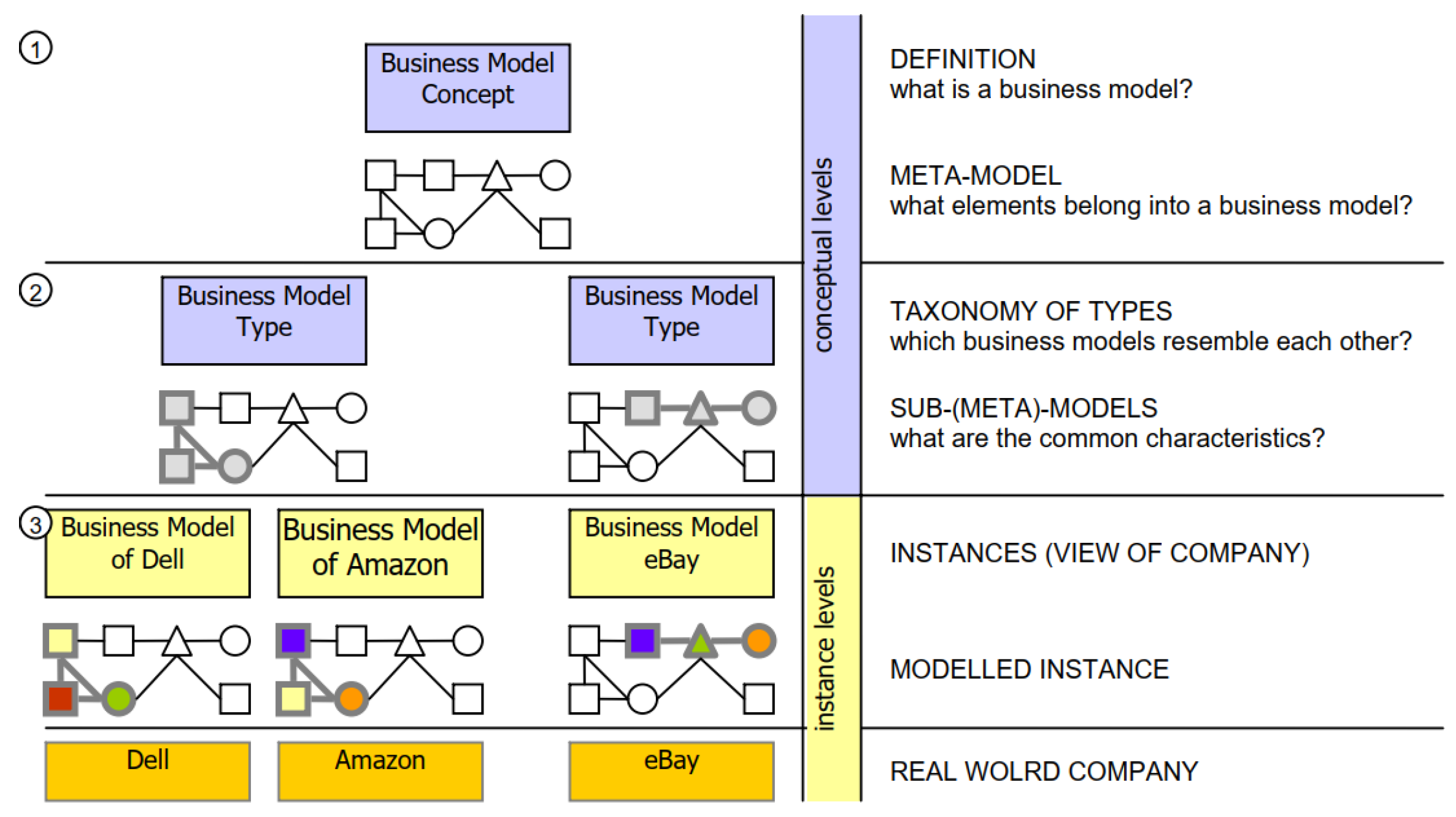
Figure 2.
RCOV framework. Adapted from Demil, 2010 Figure 1.
Figure 2.
RCOV framework. Adapted from Demil, 2010 Figure 1.
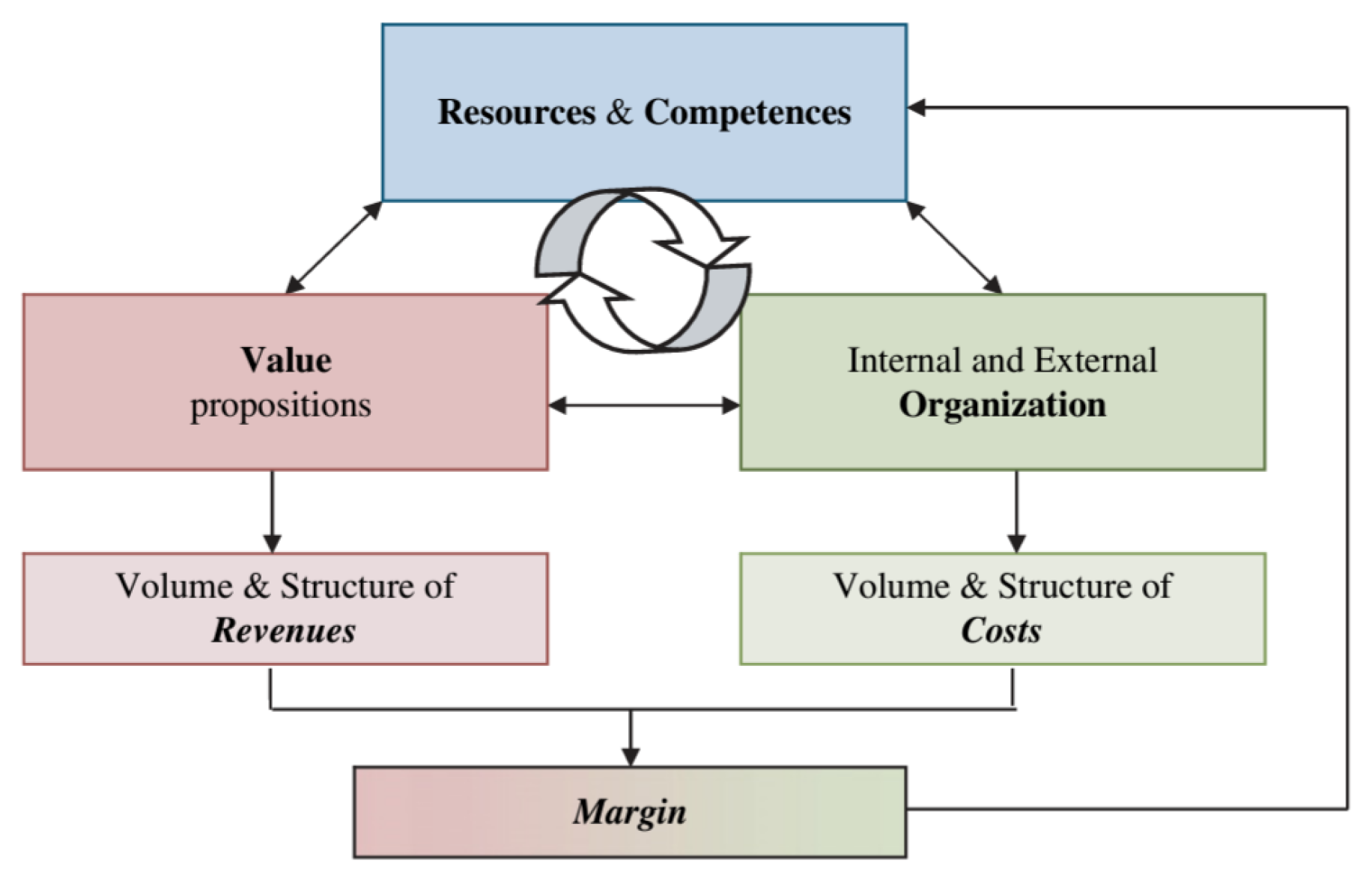
Figure 3.
Business model canvas. Adapted from A. Osterwalder and Y. Pigneur, 2010.
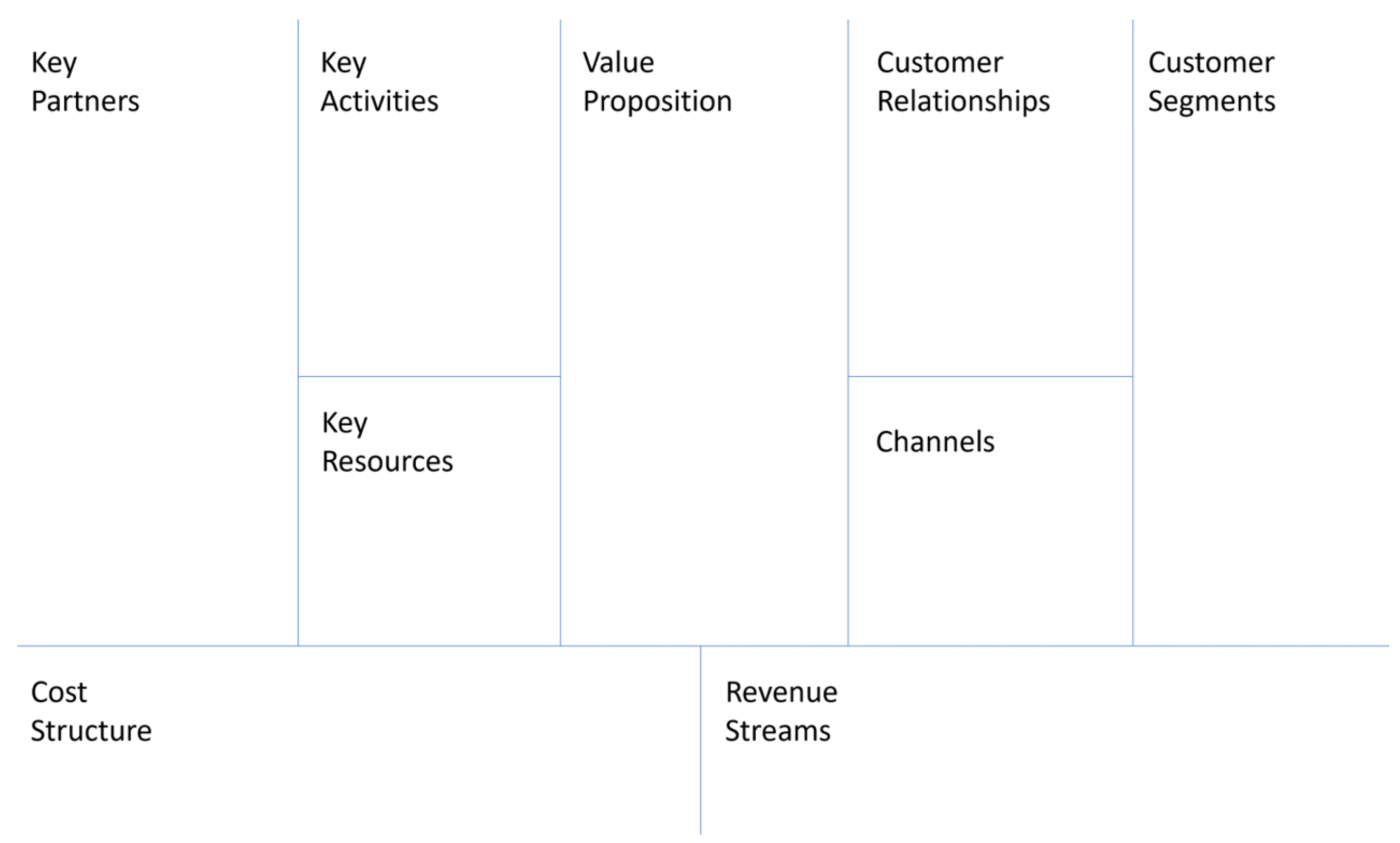
Figure 4.
Teece’s business model. Adapted from David J. Teece, 2010 Figure 1.
Figure 4.
Teece’s business model. Adapted from David J. Teece, 2010 Figure 1.
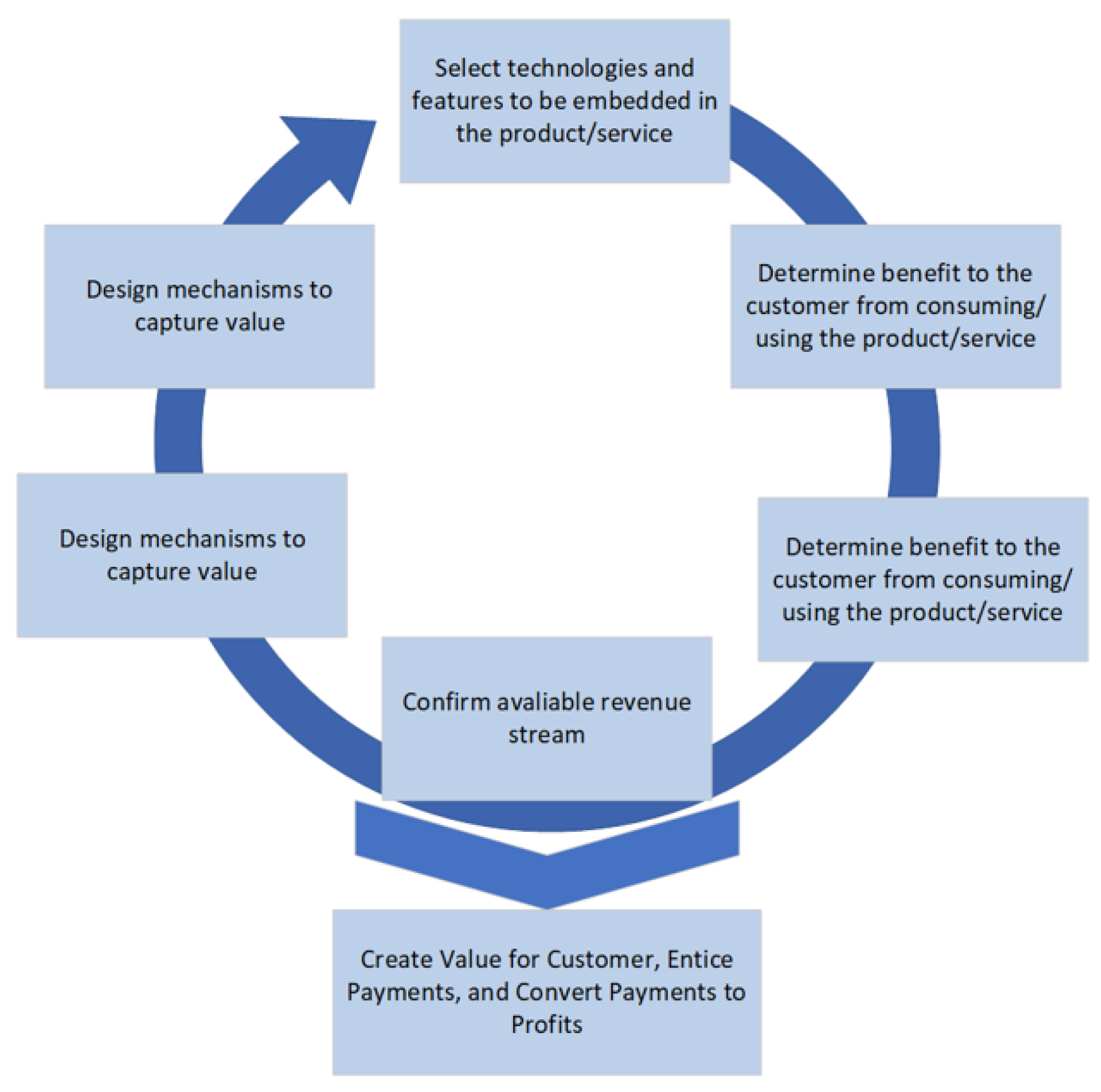
Figure 5.
Business model innovation. Adapted from Christoph Zott and Raphael Amit, 2017 Figure 1.
Figure 5.
Business model innovation. Adapted from Christoph Zott and Raphael Amit, 2017 Figure 1.
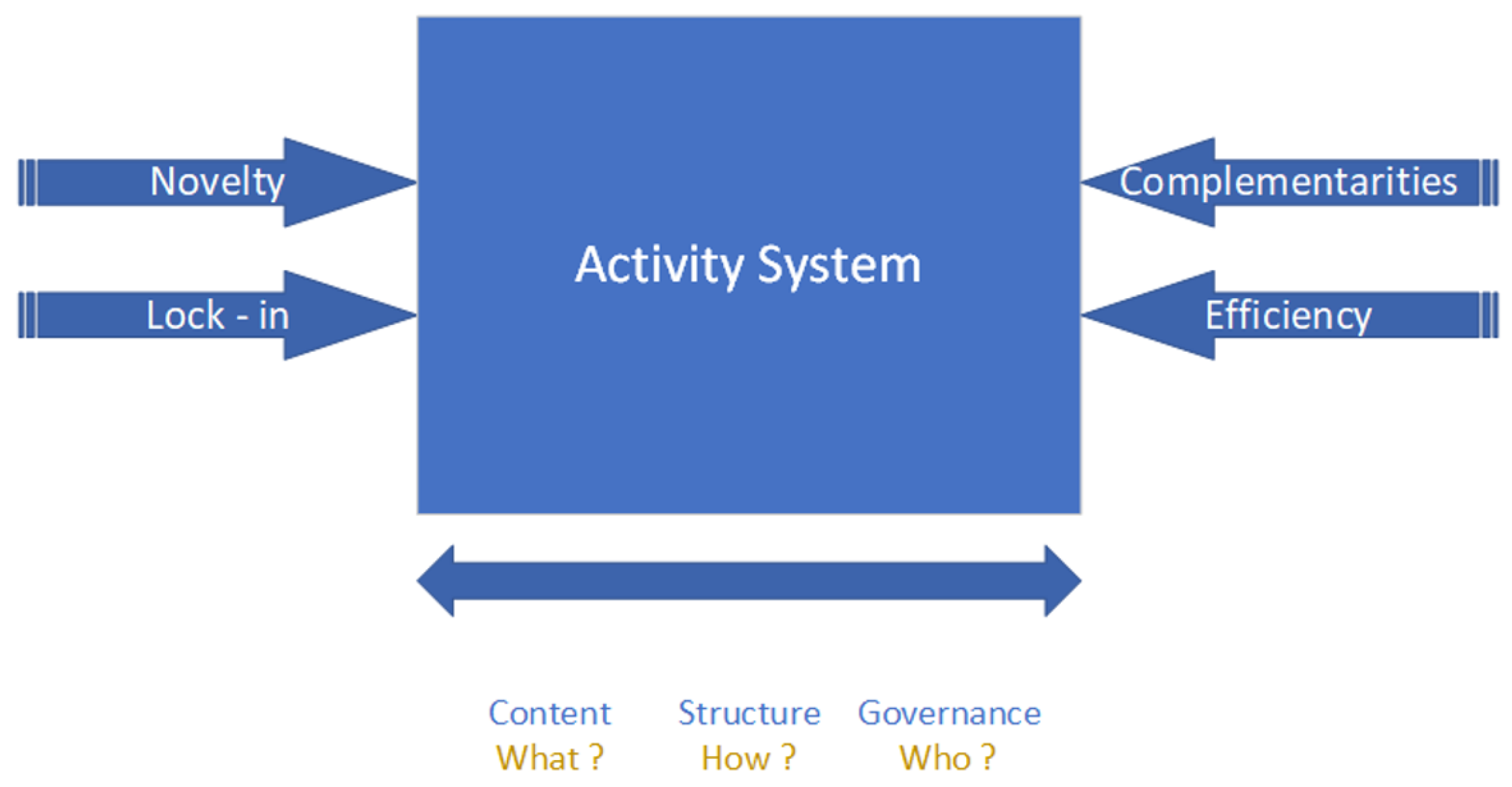
Figure 6.
Henry Chesbrough’s business model. Adapted from Henry Chesbrough and Richard S. Rosenbloom, 2002 Figure 1.
Figure 6.
Henry Chesbrough’s business model. Adapted from Henry Chesbrough and Richard S. Rosenbloom, 2002 Figure 1.
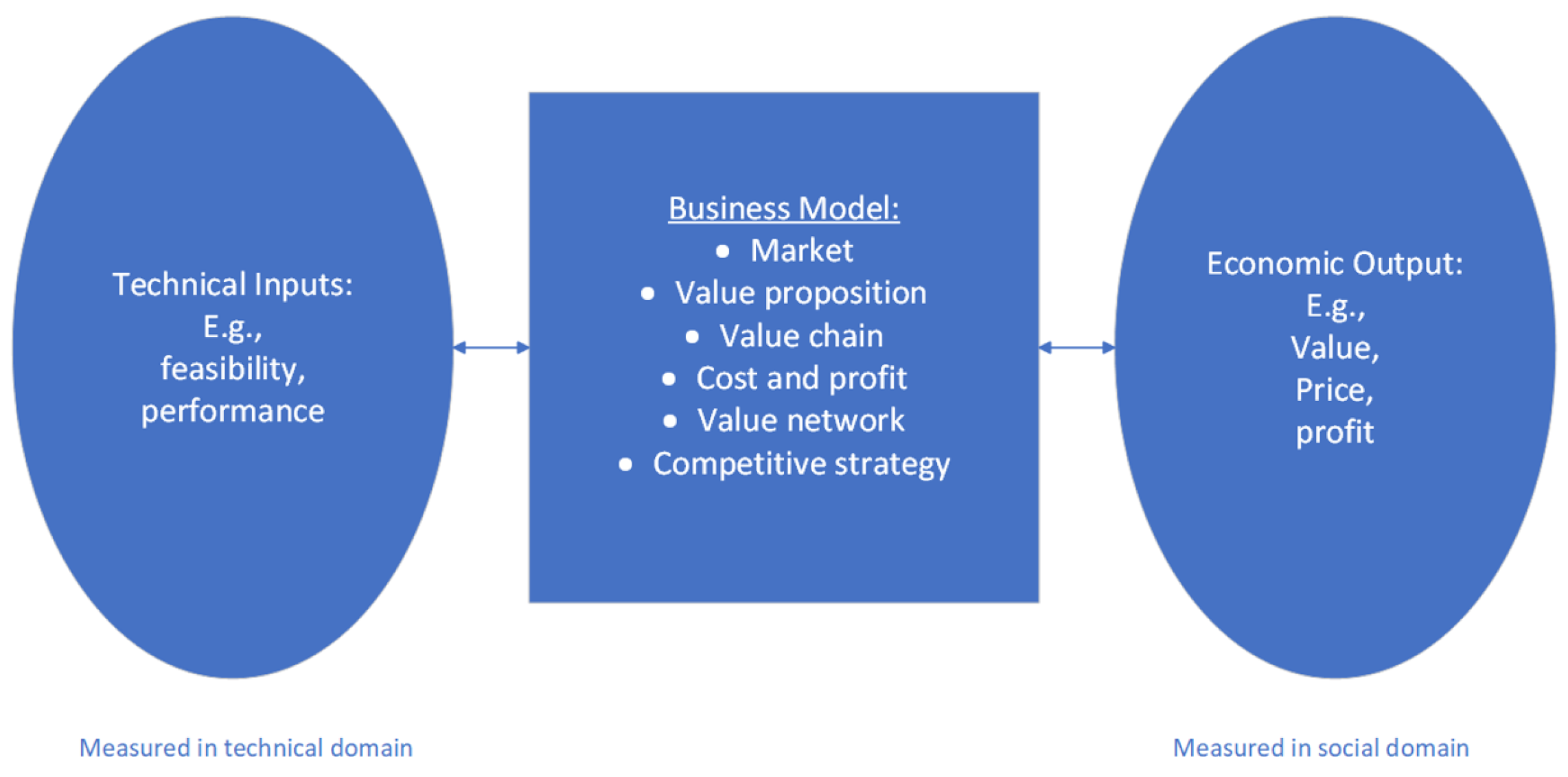
Figure 7.
Moore business ecosystem. Adapted from James F. Moore, 1996.

Figure 8.
Giesecke business ecosystem. Adapted from Raphael Giesecke, 2014.
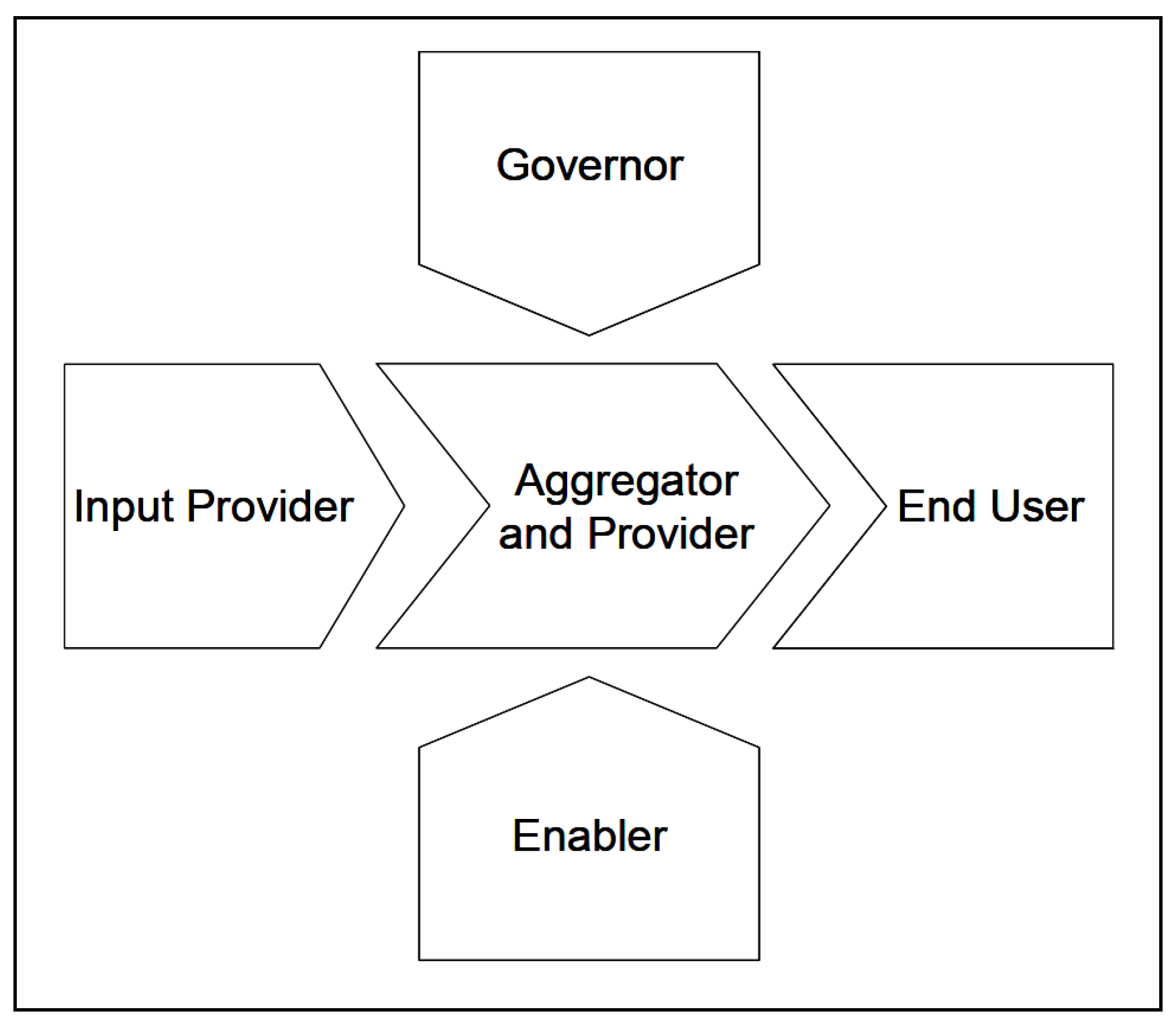
Figure 9.
Ecosystem pie model. Adapted from M. Talmar, B. Walrave et al., 2018 Figure 5.
Figure 9.
Ecosystem pie model. Adapted from M. Talmar, B. Walrave et al., 2018 Figure 5.
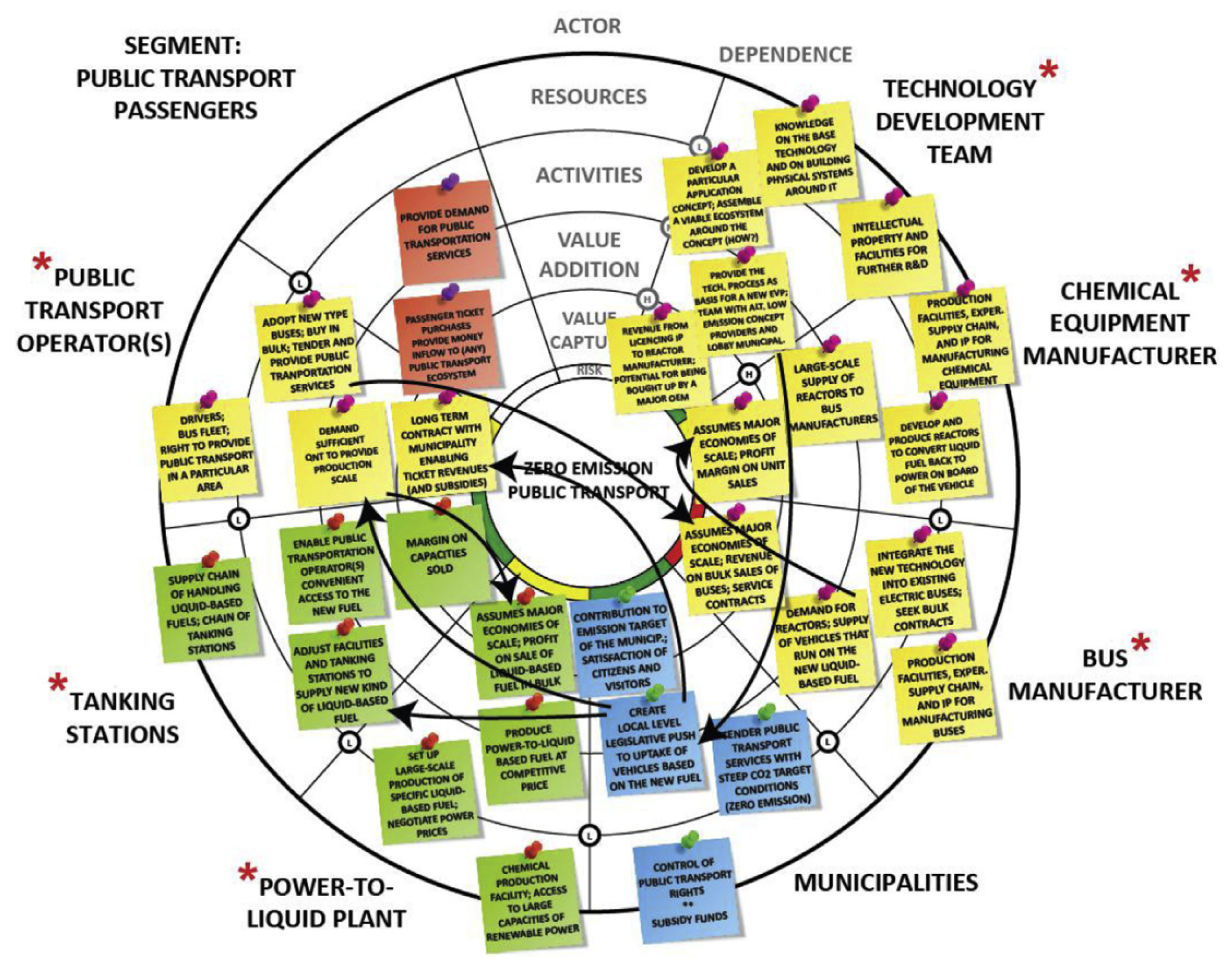
Figure 10.
Integrated business ecosystem pie model and BMC. Adapted from A. Goncearuc, N. Sapountzoglou et al., 2021 Figure 5.
Figure 10.
Integrated business ecosystem pie model and BMC. Adapted from A. Goncearuc, N. Sapountzoglou et al., 2021 Figure 5.
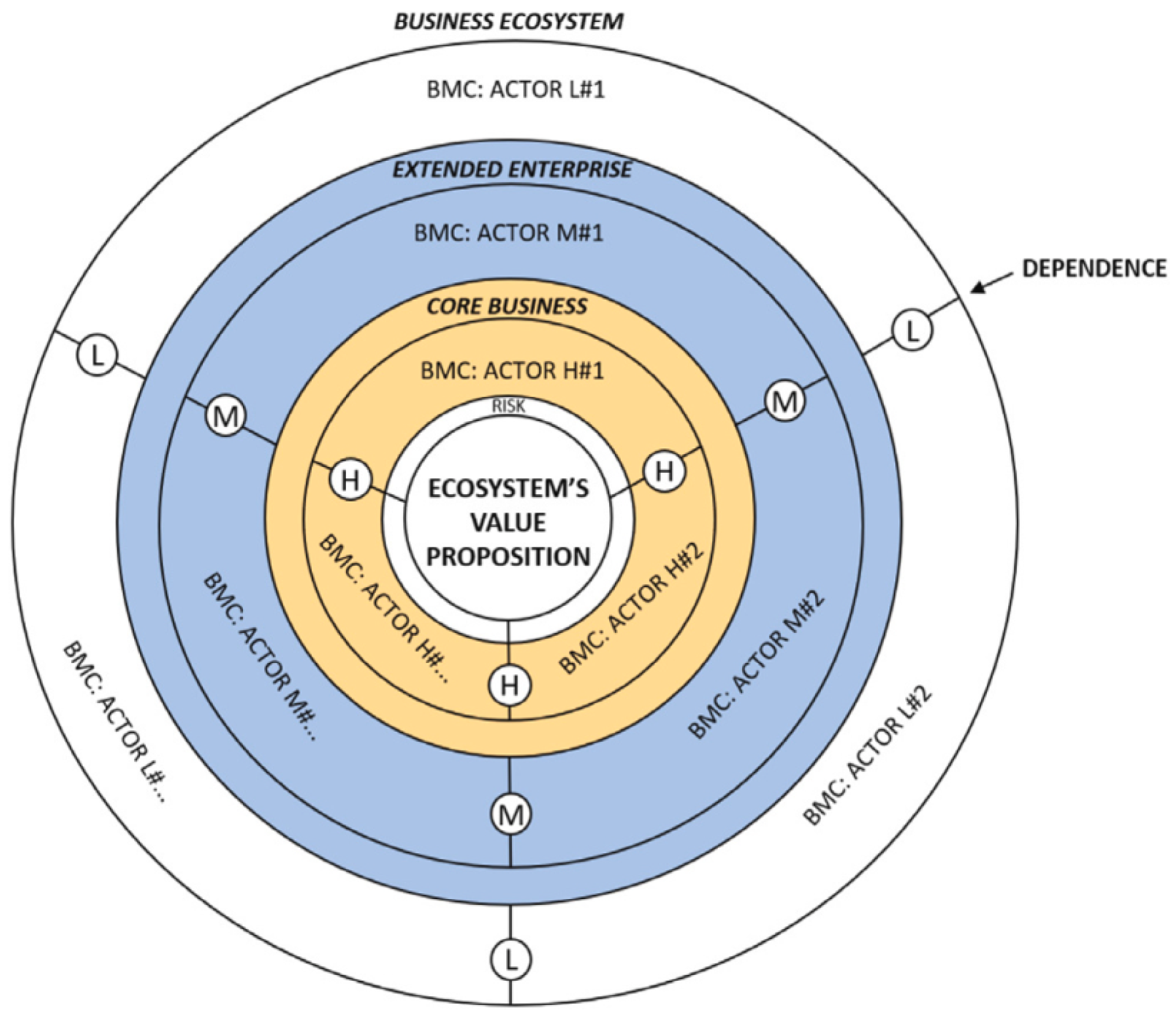
Figure 11.
SDBM-R business model. Adapted from O. Turetken, and O. Ege Adali., 2022 Figure 4.
Figure 11.
SDBM-R business model. Adapted from O. Turetken, and O. Ege Adali., 2022 Figure 4.
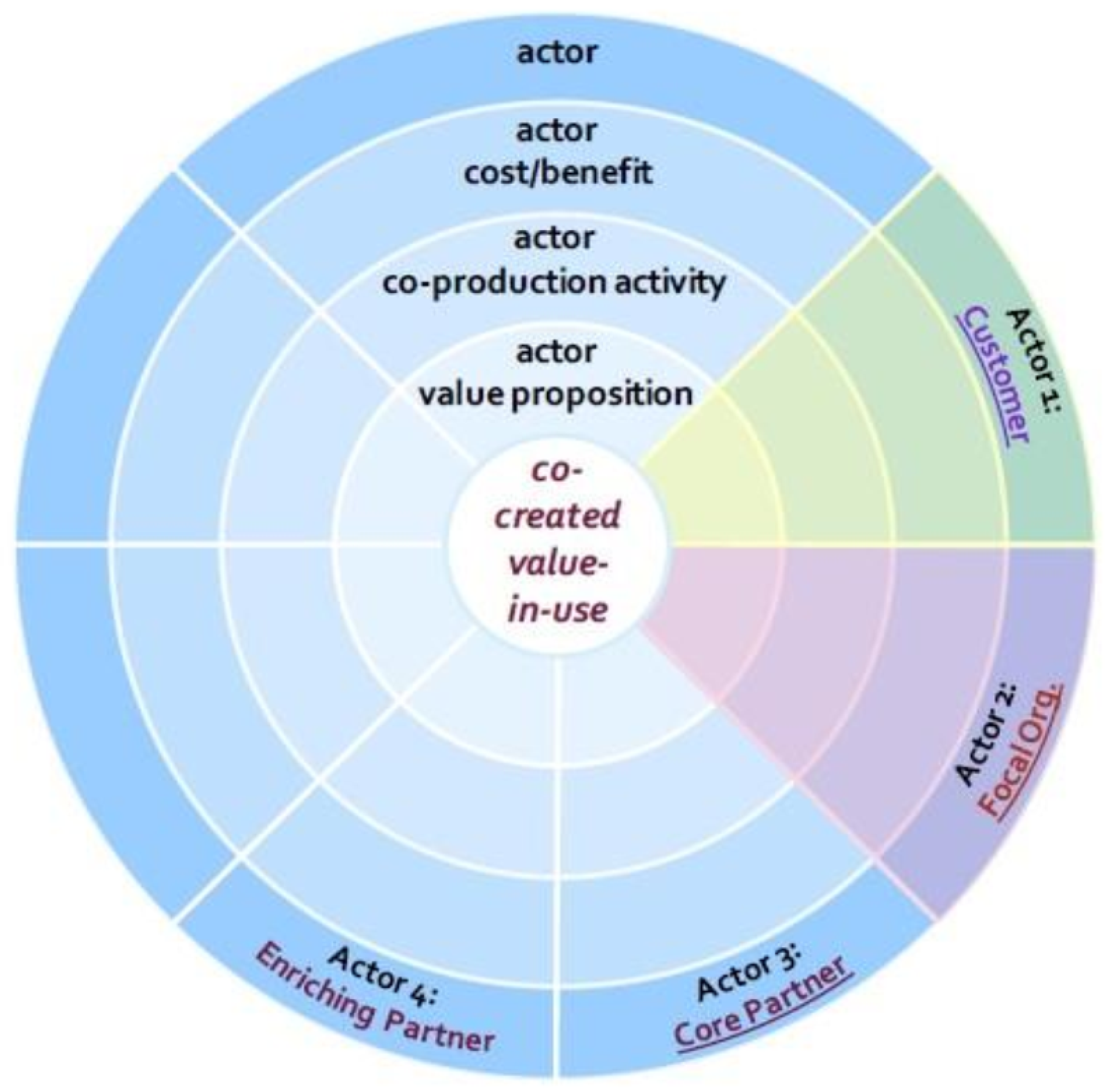
Figure 12.
Systematic diagram for the business model of electric vehicle services in tourist areas.
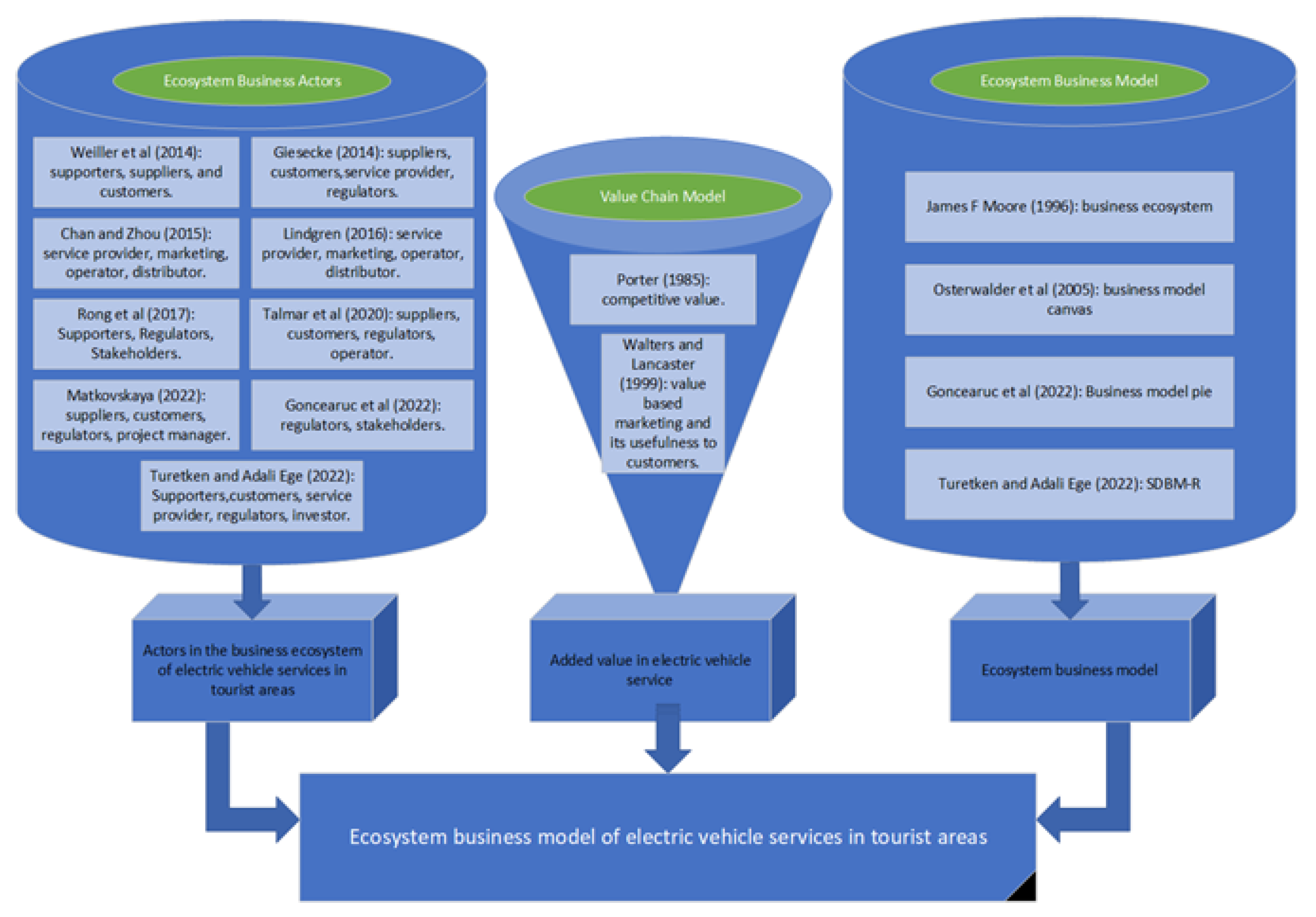
Table 1.
Comparison of business models and actors in various electric vehicle ecosystems.
| Reference | Business Model | Business Model Actor | Object | Actor Description | |||||||||||
|---|---|---|---|---|---|---|---|---|---|---|---|---|---|---|---|
| 1 | 2 | 3 | 4 | 5 | 6 | 7 | 8 | 9 | 10 | 11 | 12 | ||||
| Weiller et al., 2014 [31] | Value Creation (Amit and Zott) | ✓ | ✓ | ✓ | E-Mobility |
1. Supporters 2. Suppliers 3. Customers 4. Service Provider 5. Regulators 6. Stakehol- ders 7. Project manager 8. Transporta- tion agency 9. Marketing 10. Operator 11. Distri- butor 12. Investor |
|||||||||
| Giesecke, 2014 [27] | Giesceke Business Model | ✓ | ✓ | ✓ | ✓ | EV Management | |||||||||
| Chan et al., 2015 [32] | Value Capture (Chesbrough) | ✓ | ✓ | ✓ | ✓ | EV Infrastructure | |||||||||
| Lindgren, 2016 [33] | Value Chain (Porter) | ✓ | ✓ | ✓ | Danish Energy | ||||||||||
| Rong et al., 2017 [34] | Business Ecosystem | ✓ | ✓ | ✓ | EV Ecosystem | ||||||||||
| Talmar et al., 2020 [29] | Value Capture (Teece) | ✓ | ✓ | ✓ | ✓ | Public Transportation | |||||||||
| Matkovskaya, 2022 [12] | Multi-project Approach | ✓ | ✓ | ✓ | ✓ | Project Management | |||||||||
| Goncearuc et al., 2022 [14] | Business Model Canvas | ✓ | ✓ | EV Charging Market | |||||||||||
| Turetken et al., 2022 [1] | Value Capture (Teece) | ✓ | ✓ | ✓ | ✓ | ✓ | Share Mobility/ MAAS |
||||||||
| This Paper | Value Capture (Teece), Pie Model | ✓ | ✓ | ✓ | ✓ | ✓ | ✓ | EV Services | |||||||
Disclaimer/Publisher’s Note: The statements, opinions and data contained in all publications are solely those of the individual author(s) and contributor(s) and not of MDPI and/or the editor(s). MDPI and/or the editor(s) disclaim responsibility for any injury to people or property resulting from any ideas, methods, instructions or products referred to in the content. |
© 2024 by the authors. Licensee MDPI, Basel, Switzerland. This article is an open access article distributed under the terms and conditions of the Creative Commons Attribution (CC BY) license (http://creativecommons.org/licenses/by/4.0/).
Copyright: This open access article is published under a Creative Commons CC BY 4.0 license, which permit the free download, distribution, and reuse, provided that the author and preprint are cited in any reuse.
Downloads
46
Views
57
Comments
0
Subscription
Notify me about updates to this article or when a peer-reviewed version is published.
MDPI Initiatives
Important Links
© 2025 MDPI (Basel, Switzerland) unless otherwise stated






